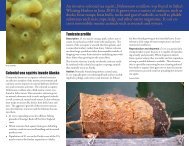Factors Contributing to Water-Column Light Attenuation
Factors Contributing to Water-Column Light Attenuation
Factors Contributing to Water-Column Light Attenuation
Create successful ePaper yourself
Turn your PDF publications into a flip-book with our unique Google optimized e-Paper software.
36 SAV TECHNICAL SYNTHESIS II<br />
computer programs have been written <strong>to</strong> solve the<br />
equations by various numerical methods (Mobley et al.<br />
1993). Despite the complexities of the radiative transport<br />
equations, field measurements of underwater<br />
irradiance nearly always show a negative exponential<br />
decay of light with depth. In the absence of strong discontinuities<br />
in water quality, such as nepheloid layers,<br />
subsurface chlorophyll a maxima or humic-stained surface<br />
layers, measurements of pho<strong>to</strong>synthetically active<br />
radiation (PAR, 400-700 nm) are well described by a<br />
single exponential equation of the form<br />
IZ2 = IZ1exp[-Kd(Z2 - Z1)] (IV-1)<br />
where IZ1 and IZ2 are irradiances at depth Z1 and Z2<br />
(Z2>Z1), and Kd is the diffuse attenuation coefficient<br />
for PAR. Several expressions useful for describing the<br />
light available <strong>to</strong> SAV are easily derived from Equation<br />
IV-1. For example, if Z1 represents the surface<br />
(depth=0) and Z2 is the maximum depth of SAV colonization,<br />
Zmax, then the percentage of surface light<br />
penetrating through the water (PLW) <strong>to</strong> the plants at<br />
depth Zmax is given by<br />
PLW = exp(-KdZmax)*100 (IV-2).<br />
We denote the minimum PLW required for growth as<br />
the water-column light requirement (WCLR). In<br />
Equation IV-2 and the equations that follow, it should<br />
be unders<strong>to</strong>od that decimal fractions are being used<br />
for quantities such as PLW and WCLR, expressed as<br />
percentages (i.e. 22 percent=0.22). If WCLR is<br />
known, then the largest diffuse attenuation that would<br />
permit growth <strong>to</strong> depth=Zmax is given by<br />
Kd = ln(WCLR)/Zmax<br />
(IV-3).<br />
Expressing Kd in Equation IV-3 as a function of the<br />
optically active water quality parameters forms the<br />
basis for the diagnostic <strong>to</strong>ol for identifying a range of<br />
water quality conditions necessary for achieving the<br />
water-column light target.<br />
PARTITIONING SOURCES OF<br />
WATER-COLUMN LIGHT ATTENUATION<br />
Underwater light is attenuated by water itself and by<br />
certain dissolved and particulate substances. The optically<br />
important water quality parameters are colored<br />
dissolved organic matter or yellow substance (Kirk<br />
1994), and suspended particulate matter. Suspended<br />
particulate matter can be further characterized by its<br />
contributions from fixed (i.e., noncombustible) suspended<br />
solids composed of clay, silt and sand mineral<br />
particles, and volatile (i.e., combustible) suspended<br />
solids composed of phy<strong>to</strong>plank<strong>to</strong>n chlorophyll a and<br />
nonpigmented organic detritus. Each of the materials<br />
has characteristically shaped light absorption spectra.<br />
Because PAR is measured over a wide range of wavelengths,<br />
the spectral dependence of absorption means<br />
that the effect of one material, for example, phy<strong>to</strong>plank<strong>to</strong>n,<br />
on light attenuation will depend on the concentrations<br />
of other materials present at the same<br />
time. For this and other reasons related <strong>to</strong> the nonlinearity<br />
of the radiative transport equations, the concept<br />
of a partial attenuation coefficient for the various<br />
optical water quality parameters is only an approximation,<br />
and one that has been criticized (Kirk 1994). In<br />
spite of these known limitations in partitioning the diffuse<br />
attenuation coefficient in<strong>to</strong> contributions due <strong>to</strong><br />
individual components, that approach is adopted here<br />
because of the need <strong>to</strong> derive a <strong>to</strong>ol that is simple <strong>to</strong><br />
use with large amounts of data and can be interpreted<br />
by managers unacquainted with the details of radiative<br />
transport theory.<br />
First, the attenuation coefficient for downwelling<br />
(moving down through the water) light is expressed as<br />
the sum of that due <strong>to</strong> water (W) plus dissolved<br />
organic matter (DOC), phy<strong>to</strong>plank<strong>to</strong>n chlorophyll a<br />
(Chl) and <strong>to</strong>tal suspended solids (TSS). Based on the<br />
analyses presented below, it is assumed that attenuation<br />
due <strong>to</strong> dissolved matter is relatively constant and<br />
may be included with water itself. We further assume<br />
that the contributions <strong>to</strong> light attenuation due <strong>to</strong><br />
chlorophyll a and <strong>to</strong>tal suspended solids are proportional<br />
<strong>to</strong> their concentrations, so that the diffuse attenuation<br />
coefficient may be written as<br />
Kd = K(W+DOC) + kc[Chl] + ks[TSS] (IV-4)<br />
where K(W+DOC) is the partial attenuation coefficient<br />
due <strong>to</strong> water plus colored dissolved matter, and kc and<br />
ks are the specific-attenuation coefficients due, respectively,<br />
<strong>to</strong> chlorophyll a and <strong>to</strong> <strong>to</strong>tal suspended solids.<br />
By combining equations IV-3 and IV-4, combinations<br />
of chlorophyll a and <strong>to</strong>tal suspended solids that just<br />
meet the WCLR may be calculated using:<br />
ln(WCLR)/Zmax =K(W+DOC) + kc[Chl] + ks[TSS]<br />
(IV-5).



